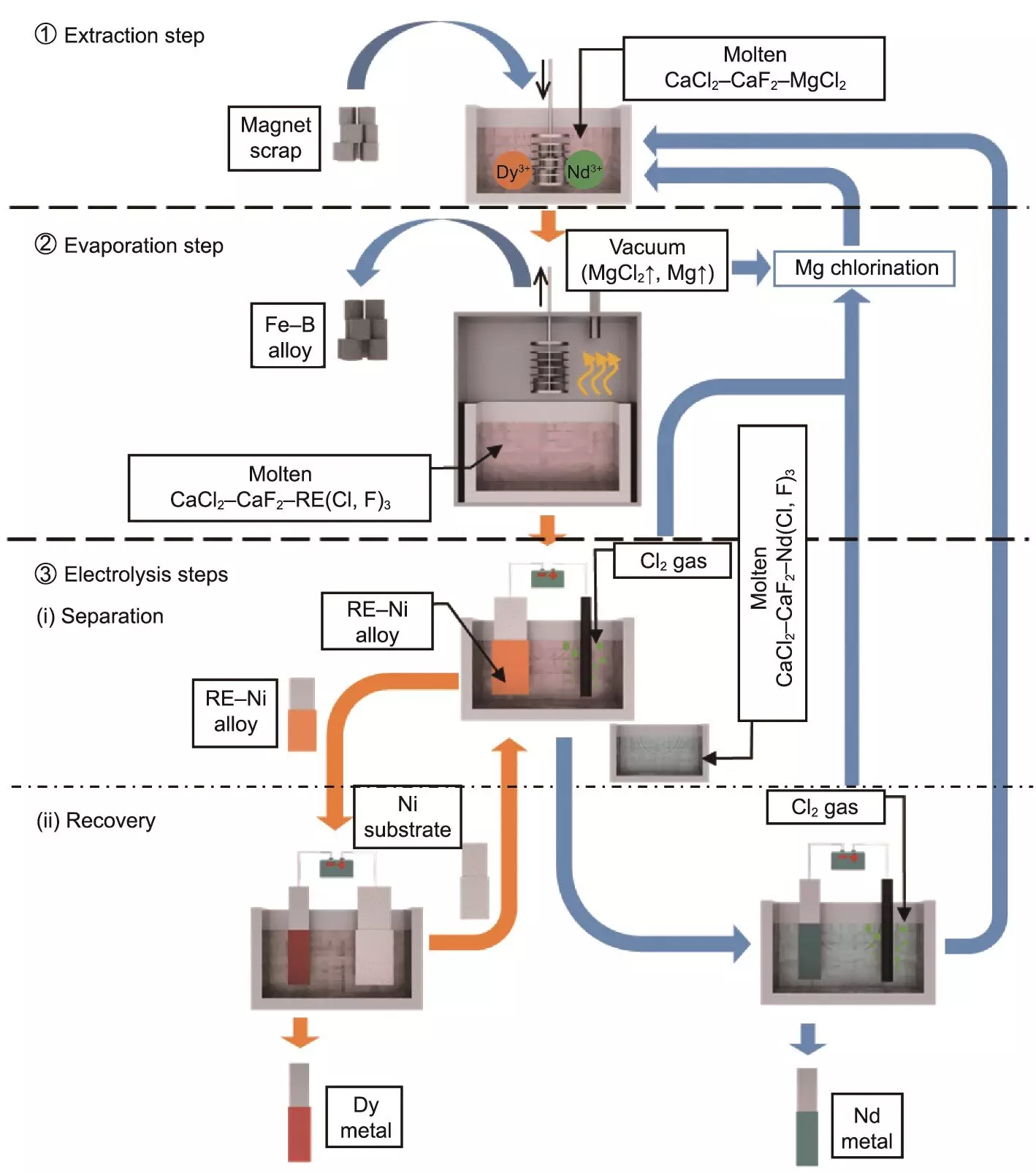The increasing reliance on green technologies, such as electric vehicles (EVs) and wind turbines, has spurred a surge in demand for rare-earth elements (REEs), particularly neodymium (Nd) and dysprosium (Dy). These components are crucial in manufacturing high-performance magnets that power advancements in sustainable energy solutions. In light of these developments, a recent study from Kyoto University introduces a groundbreaking recycling method, the Selective Extraction–Evaporation–Electrolysis (SEEE) process. This methodology doesn’t just aim to improve the efficiency of recycling REEs from discarded magnets; it invites a broader dialogue about the future of recycling technologies and their imperative role in achieving environmental sustainability.
Traditional methods of recycling rare-earth elements often rely on energy-intensive and overly complex hydrometallurgical procedures. These techniques not only consume significant amounts of energy but also typically have a substantial environmental footprint. Consequently, the imperative for discovering more efficient, sustainable practices becomes increasingly pressing. The SEEE process promises to address these shortcomings by streamlining REE recovery from old magnets in a manner that is both more efficient and environmentally considerate.
The three-stage SEEE process proposed by Kyoto University researchers marks a significant departure from traditional methods.
1. **Selective Extraction**: The process begins with a molten salt mixture, primarily consisting of calcium chloride (CaCl2) and magnesium chloride (MgCl2). This innovative combination facilitates the extraction of REEs from magnet waste. To optimize efficiency further, calcium fluoride (CaF2) is added to manage evaporation loss, ensuring a concentrated yield of valuable elements.
2. **Selective Evaporation**: Following extraction, the process moves into the selective evaporation stage, where residual extraction agents and byproducts are eliminated. This step enhances the concentration of REEs, thereby increasing the integrity of the materials obtained.
3. **Selective Electrolysis**: The final stage involves electrochemical separation of the extracted REEs, capitalizing on their differing formation potentials. This sophisticated technique results in the recovery of high-purity metals, achieving a remarkable 96% recovery rate for neodymium and 91% for dysprosium, both exceeding purities of 90%.
The emergence of the SEEE process is particularly timely, given the escalating global demand for sustainable energy solutions. Traditional mining of rare-earth elements has devastating environmental repercussions, emphasizing the urgent need for a systematic recycling approach that minimizes ecological damage. By repurposing existing resources, the SEEE method not only supports a circular economy but also diminishes reliance on fresh mining operations—an essential consideration in today’s climate crisis.
Moreover, the adaptability of the SEEE process extends beyond just neodymium magnets; its potential for application in nuclear fuel reprocessing highlights the versatility of this breakthrough technology. This could open new avenues for sustainable practices across various industries, emphasizing the importance of advanced research in fostering innovative solutions.
Despite the promising results showcased by the SEEE process, researchers acknowledge that further investigation is crucial for its full industrial implementation. Real-world applications require rigorous testing to ensure the stability and scalability of this method in various contexts. While the initial findings exhibit exceptional efficiency, the transition from laboratory success to practical application often presents considerable challenges.
As a result, ongoing support for research and development in this field is imperative. Continued innovation in recycling technologies will play a pivotal role in aligning with global sustainability goals. This research not only reflects a proactive stance towards resource management but also symbolizes a broader commitment to environmentally conscious practices on a global scale.
The Kyoto University study heralds a new era in the recycling of rare-earth elements, underscoring the significance of advanced methods such as the SEEE process in mitigating the ecological impact of industrial activities. As society continues to navigate the challenges of climate change and resource scarcity, innovations like the SEEE method stand as a beacon of hope, offering practical solutions to promote sustainability in the essential materials that drive our future. The pathway to a carbon-neutral future hinges on such transformative research, encouraging a shift toward greater efficiency and responsibility in resource utilization.


Leave a Reply